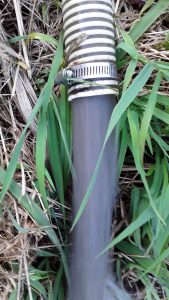
Have you had your water tested lately?
Sulfur Odors In Well Water.
Water containing hydrogen sulfide gas (H2S) has a distinctive “rotten egg” odor, which may be especially noticeable when running hot water. Such water can discolor beverages like coffee and tea, and alter the appearance and taste of cooked foods. Hydrogen sulfide gas is a nuisance. It is not usually a health risk at concentrations normally found in household water. But it is flammable and poisonous, and can be toxic. If enough hydrogen sulfide gas is released in a confined area, it can cause nausea, illness, and in extreme cases, death. However, the gas can usually be detected long before it reaches harmful concentrations. ” Have your well water tested to determine filtration needs,
Corrosion
CH2S dissolved in water can corrode metal pipes (iron, steel, copper, and brass) and exposed metal parts in washing machines and other water-using appliances. The corrosion of iron and steel from hydrogen sulfide forms ferrous sulfide or “black water,” which can darken silverware and discolor copper and brass utensils. Hydrogen sulfide can also interfere with the effectiveness of water softeners and filter systems. Sources present in groundwater use iron and sulfur as an energy source and chemically change sulfates to produce H2S gas. They also use sulfur available from decaying plants, rocks, or soil, and often thrive in iron-rich environments.
These bacteria s are harmless, non-toxic and normally exist in oxygen-deficient environments. But do not usually cause health problems. Although at low levels they can contribute to bad tastes and/or odors. Hydrogen sulfide gas may also be found in wells drilled in shale or sandstone, near coal or peat deposits, in oil fields, and in sewage. Though H2S is usually grows n wells, it can also enter surface water through springs but quickly escape into the atmosphere. Water heaters can also become a source of foul H2S odors. The magnesium rod used in water heaters for corrosion control can chemically reduce sulfates to H2S
Test Your Water
If your water supply has an odor problem the first step is to determine the source. If the odor comes directly from the well a mineral water test is critical to determine the right filter system. A mineral test should include pH, iron, manganese, hardness, total dissolved solids, and oxidation-reduction potential. Additional tests for sulfate, hydrogen sulfide, and tannin are recommended as well. The sample should be taken as close to the well as possible. These results can help you choose the best type of water treatment to use, and what type of system to select. (Avoid in-home water testing by water softener salespeople during sales demonstrations.)
Your water should also be tested for total coliform and e-coli (fecal coliform) to prevent health issues. Also a complete mineral, metals and bacteriological test is recommended when there will be infants or children drinking the water. If your water comes from a public water system and you experience an odor problem it is important to contact a utility official to determine where the odor comes from. It may come from the public system or your home’s plumbing or piping.
